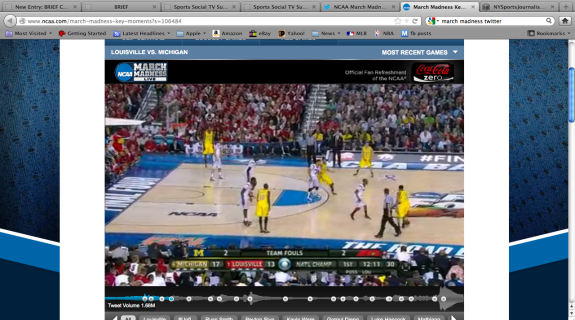The 2013 Sports Social TV Summit unfurled on Wednesday at Bel-Air Country Club in Los Angeles. The hot topic, unsurprisingly, was the monetizaton of the social media experience, whether at home or at the stadium.
It’s well-proven that sports is one of the last bastions of must-see live viewing, and it’s perhaps equally unsurprising that it also creates the most chatter on social media of almost any type of programming. A key statistic thrown around by several speakers at today’s event shows sports amounting to only 1.3% of programming across all of television, but nearly 50% of all TV-related social engagement. That’s an incredible density of engagement, and yet even the sports industry has yet to “make a monetization model around it that makes sense,” said Manish Jha, GM of mobile for the NFL. Jha spoke at a panel titled “League, TV Network, Agency, Brand and Arena Executives Discuss the Power of Live Sports Programming and How Social TV is Engaging Viewers and Driving New Revenues at Home and in Arenas and Stadiums,” which also included representatives from the Los Angeles Dodgers, Turner Sports, The Marketing Arm, Pac-12 Digital and Time Warner Cable Sports. None of these executives had the solution to Jha’s dilemma, but Pac-12 Digital’s David Aufhauser, VP and GM, saw huge potential in the recent Nielsen/Twitter partnership, which he said “will put real dollars against social media.” Aufhauser also reflected on the in-stadium experience’s potential to create new opportunities. “We have to work with telecom partners to create greater interactivity,” he said, “to give fans the ability to better share the story of the live event. But when we do solve that, it will open a huge new world of opportunities.”
For his part Lon Rosen, EVP and CMO of the Dodgers, said wiring Dodger Stadium and others for greater engagement is a priority for any one in his position. “You can barely send a text in a lot of stadiums, “he said. “The infrastructure needs to enable social engagement.”
Following an entertaining, if rather predictable onstage Q & A with Los Angeles Laker guard Steve Blake and his wife, Kristen, about tweeting as a professional basketball player, a later session covered the engagement of fans around BIG events such as the Super Bowl and the NFL Draft. Sports marketers may have not yet figured out how to monetize cool social experiences, but that’s not stopping them from creating them. Gabe Goodwin, for instance, senior director of social production at ESPN, presented his team’s revelatory manipulation of the basic Twitter hashtag during the network’s NFL Draft coverage. Without any specially built apps or other bells and whistles, ESPN posted on-screen hashtags at key moments, synching them up with new player announcements, and in so doing creating its own organic trending topics each hour of the broadcast. Their coordinating efforts allowed them to control the Twitter waterfall as much as it currently seems possible to control it.
So while social money in sports may still be on the horizon, today’s Summit showed that social sports innovation is right in front of us. Read more about the day’s sessions and speakers and also check out the winners at the evening’s Sports Social TV Summit Awards Ceremony on the event’s website.
Tags:













































__twocolumncontent.jpg)










